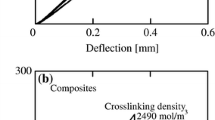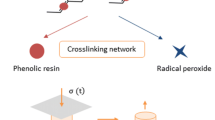Abstract
Cenospheres (hollow, aluminum silicate spheres ranging from 10 to 400 μm in diameter) are used as filler in a homogeneous polyester composite. Particle size was varied to study its effect on mechanical properties of the composite. The effect of particulate surface modification using a silane coupling agent was also studied. Properties of the composites were characterized using standard testing methods. When compared to the largest particulate used, an increase in compression strength was achieved by particle size reduction and use of coupling agent. The Elastic modulus increased by using fine particles, while Poisson's ratio remained constant and independent of silane treatment or particle size. Fracture toughness increased with particle size reduction and increased further with silane surface modification. Dynamic compressive strength increased with particle size reduction, while silane did not show improvement. The addition of cenospheres as well as silane treatment increased the glass transition temperature for polyester. A given mass fraction of particulate, of a mean diameter D, will have the surface area between the particulate and matrix scale as D −1 (specific surface area). The sensitivity of these properties to cenosphere size is a direct function of the interfacial surface contacts between the polyester and the cenospheres and the specific surface area.
Similar content being viewed by others
References
T. WANDELL, The American Ceramic Bulletin 75(6) (1996) 79.
S. PERVEZ, G. S. PANDEY and V. K. JAIN, Research and Industry 38 (1993) 99.
R. M. CLAYTON and L. H. BACK, Journal of Engineering for Gas Turbines and Power 111 (1989) 679.
P. K. ROHATGI, R. Q. GUO, B. N. KESHAVARAM and D. GOLDEN, Transactions of the American Foundrymen's Society (103) (1995) 575.
E. E. BERRY, R. T. HEMMINGS and J. LEIDNER, Plastics Compounding 9(7) (1986) 12.
N. CHAND, J. Mater. Sci. Lett. 7(1) (1988) 36.
V. PARAMESWARAN and A. SHUKLA, J. Mater. Sci. 35 (2000) 1.
Idem., ibid. 33 (1998) 3303.
American Society for Testing and Materials, “Standard test method for tensile properties of plastics,” Annual Book of ASTM Standards, Designation D638-98 (1998).
American Society for Testing and Materials, “Standard test method for compressive properties of rigid plastics,” Annual Book ofASTM Standards, Designation D695-96 (1996).
American Society for Testing and Materials, “Standard test methods for plane-strain fracture toughness and strain energy release rate of plastic materials,” Annual Book of ASTM Standards, Designation D5045-99 (1999).
H. KOLSKY, “Stress Waves in Solids,” Dover Publications, Inc. (New York, 1963).
S. P. KIM and S. C. KIM, Polymer Engineering and Science 31(2) (1991) 110.
PÉEREZ-CÁRDENAS, C. FERNANDO, DEL CASTILLO, FELIPE and VERA-GRAZIANO, RICARDO, J. Appl. Polym. Sci. 43 (1991) 779.
W. H. BEYER, “CRC Standard Mathematical Tables and Formulae” (CRC Press, Florida, 1991) p. 514.
Author information
Authors and Affiliations
Corresponding author
Rights and permissions
About this article
Cite this article
Cardoso, R.J., Shukla, A. & Bose, A. Effect of particle size and surface treatment on constitutive properties of polyester-cenosphere composites. Journal of Materials Science 37, 603–613 (2002). https://doi.org/10.1023/A:1013781927227
Issue Date:
DOI: https://doi.org/10.1023/A:1013781927227




